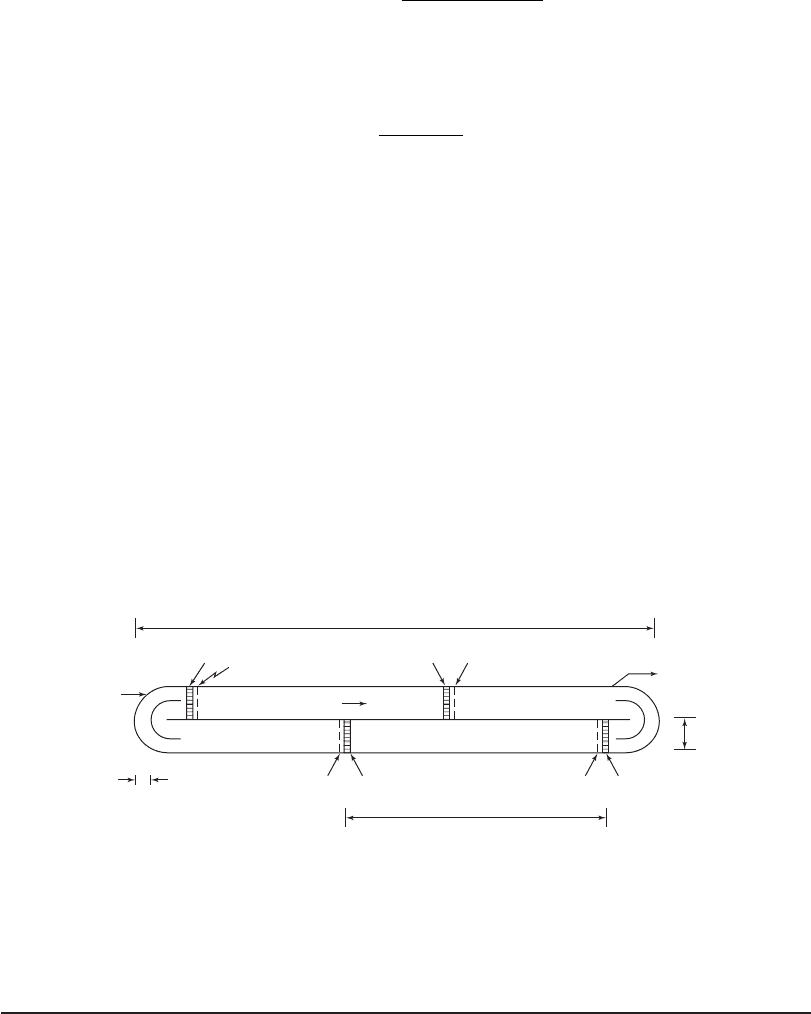Water and Wastewater Engineering
Подождите немного. Документ загружается.


23-58 WATER AND WASTEWATER ENGINEERING
b. Estimate the amount of sodium bicarbonate to add.
The equivalent weight of NaHCO
3
84 g/equiv
The equivalent weight of CaCO
3
50 g/equiv
NaHCO required
kg/d g/equiv
3
14598 84
50
()(),.
g/equiv
or kg/d 24524 2450,. ,
Comment. This dose is an estimate. The chemical feed system should be flexible enough to
allow the operator to adjust the dose.
Example 23-10. Estimate the mass of sludge to be wasted each day from the extended aeration
oxidation ditch at Cartouche Lake ( Example 23-8 ).
Solution:
a . Assume that kinetic coefficients for heterotrophic bacteria govern because the fraction
of heterotrophic bacteria is m uch greater than the fraction of nitrifying bacteria. From
Table 23-13 , Y 0.40 g VSS/g bCOD and k
d
0.12 d
1
.
b. Begin by calculating Y
obs
using Equation 23-37. Use
c
2.5(5.26 d) 13.15 d and a cor-
rected k
d
0.09 d
1
from Example 23-8.
Y
obs
gVSS/gbCODremoved
d
040
1009
1
.
.[( )
(()]13 15
0183
.
.
d
gVSS/gbCODremoved
c. Estimate the net waste activated sludge produced each day using Equation 23-38.
P
x
()( )( )(0183 14 200 205 010
333
.,m /d g/m g/m
3
5327 533
kg/g
kg/d
)
.or
d. Because a primary settling tank is not included in the process flow scheme, the additional
inert solids in the raw wastewater will pass through the oxidation ditch to the secondary
clarifier. The concentration of inert solids is estimated as
Inert SS TSS Biodegradable volatile suspend eed solids
Using the data from Example 23-8 :
Inert SS mg/L mg/L mg/L160 95 65
The mass of inert SS is estimated as
Inert SS mass Inert SS
Inert SS g/m
()()
(
Q
65
3333
14 200 10
923 920
)( )( ), m /d kg/g
or kg/d

SECONDARY TREATMENT BY SUSPENDED GROWTH BIOLOGICAL PROCESSES 23-59
e. Assuming the secondary clarifier meets the design goal of 10 mg/L TSS in the effluent,
the mass of solids (both volatile and inert) lost in the effluent is estimated as
()( ) ( )( )( )QX
e
14 200 10 10
1
333
, m /d g/m kg/g
442 kg/d
The mass to be wasted is then
Mass to be wasted kg/d kg/d kg/533 920 142 dd or kg/d1 311 1 300,,
Comments:
1 . The mass is for the total flow from the two oxidation ditches defined by Example 23-8.
2. Note that the biomass is substantially less than mass of inert materials.
3. The estimate of the mass of solids in the effluent is high because the flow rate for wast-
ing is not included.
4. The mass to be wa
sted is calculated as dry solids. Because the sludge is mostly water, the
actual mass will be considerably larger. This is discussed in Chapter 15.
Example 23-11. Determine the total length of brush aerators for the extended aeration oxida-
tion ditch at Cartouche Lake ( Ex
ample 23-8 ). Use the data in Table 23-15 for the length estimate.
Use the following assumptions in the design:
Clean water correction, 0.60 for nitrification
Salinity correction, 0.95
S ummer wastewater temperature 22 C
Operating DO 3.0 mg/L
Solution:
a . Using Equation 23-44 and the data from Examples 23
-9 and 23-10 to estimate the mass
of oxygen to be supplied (kg/d):
M
O
2
m /d g/m kg/g
()( )()14 200 205 010 1
333
,.442 533
4 33 14 200 16 8 1
33
()
()(
kg/d
m /d g/m., . g/m /g
kg/d kg/d
33
10
2 911 7569 97
)( )
.
kg
,11 5
33130
.
,125.6 ,
kg/d
or kg/d of oxygen
This is the required AOTR.
b. Using the form of Equation 23-50 for mechanical aerators, that is, C
avg
C
s, T, H
and
F 1.0:
AOTR SOTR
()( )
(
CC
C
sT H L
s
T
,,
.
20
20
1 024
⎛
⎝
⎜
⎞
⎠
⎟
))( )

23-60 WATER AND WASTEWATER ENGINEERING
Solve for SOTR
req
:
SOTR
AOTR
req
req
()()
()(
1 024
20
20
.
,,
T
s
sT H
C
C
C
L
)
⎛
⎝
⎜
⎞
⎠
⎟
c. From Appendix A, C
s, 20
9.17 mg/L or 9.17 g/m
3
at 20
C and C
s, T, H
8.83 mg/L
or 8.83 g/m
3
at 22
C.
d. Calculate SOTR
req
SOTR
kg/d
req
3 130
1 024 0 6
9
22 20
,
..
.
()()
⎛
⎝
⎜
⎞
⎠
⎟
117
095 88330
3
mg/L
mg/L mg/L()( ).. .
,
⎛
⎝
⎜
⎞
⎠
⎟
1130
063
917
554
8
kg/dmg/L
mg/L.
.
.
⎛
⎝
⎞
⎠
⎛
⎝
⎜
⎞
⎠
⎟
,, . ,223 6 8 200or kg/d
e. Using the highest transfer rate, calculate the total length of rotor from the manufacturer’s
data in Table 23-15 . For Model U:
8 200
82 24
41
2
2
,
.
.7
kg O /d
kg O /h m h/d()()
m or 42 m of rotor U
This estimate is the total length of rotor for the two oxidation ditches.
Comment. The selection of the appropriate rotor and the number of rotors is a function of the
channel dimensions, velocity, and the manufacturer’s constraints. The design process is explained
in Example 23-12.
Example 23-12. Determine the oxi
dation ditch dimensions and select brush aerators for the
extended aeration oxidation ditch at Cartouche Lake (Examples 23-8 and 23-9). Use the data in
Tables 23-15 and 23-16 .
Solution:
a . Assume a four-rotor configuration and estimate the length of an individual rotor using
the total rotor length calculate
d in Example 23-11 :
41
24
.7 m
oxidation ditches rotors per di()(
ttch
m/rotor
)
5.2
From Table 23-15 , the Model U rotor can be used.
b. For four rotors the maximum length of the oxidation ditch should be 288 m from the
“aerator placement” discussion.

SECONDARY TREATMENT BY SUSPENDED GROWTH BIOLOGICAL PROCESSES 23-61
c. The cross-sectional area of the ditch is then
area
Volumeofditch
Length of ditch
From Example 23-8 , the volume of each ditch is 4,700 m
3
.
area
m
m
m
4 700
288
16 32
3
2
,
.
As a first trial, assume a square cross section. The width and depth of the channel are
estimated as
width depth m or m
/
()16 3240440
212
...
The depth of the channel is 4.0 m plus 0.5 m freeboard.
d. From Table 23-16 , the maximum depth for rotor Model U is 5 m. Therefore, the trial
dimensions are acceptable.
e. The radius of the return channel is the width of the channel. The return flow baffle is
placed at 4.0 m/2 2.0 m from the edge of the channel. It is offset into the downstream
flow W /15 4.0 m/15 0.267 or 0.3 m.
f. Because the depth is greater than 2 m, a submerged baffle is required d ownstream of
each rotor.
g. A sketch of the oxidation ditch layout is shown below.
Influent
Rotor
Baffle
F
low
Baffle
Baffle
Rotor
Baffle
Rotor
Rotor
8.8 m
Effluent
144 m
72 m
4.4 m
Comments:
1 . Other combinations of these dimensions will also be acceptable.
2. Alternate rotors should be evaluated based on economic considerations. If other rotors
are considered, then the calculations in Example 23-11 that were used as a starting point
for calculation in this exam
ple would also have to be reworked.

23-62 WATER AND WASTEWATER ENGINEERING
Sequencing Batch Reactor
This is an example of processes used for carbonaceous BOD oxidation, nitrification, and
denitrification. Other processes that perform these treatment functions are listed in Tables 23-2
and 23-3 .
A s of 1997, approximately 80 percent of the sequencing batch reactors (SBR) plants operating
in the United States
had flow rates less than 4,000 m
3
/ d, and 70 perc ent had flows less than
2,000 m
3
/ d. Although plants as large as 57,000 m
3
/ d have been built internationally, the larger
plants in the United States typically have not exceeded 20,000 m
3
/ d (WEF, 1998). Performance
data from 19 plants indicate that they are capable of meeting annual BOD
5
discharge limits of
15 mg/L, and total suspended solids (TSS) discharge limits of 15 mg/L. They can achieve nitrifica-
tion levels of 90–96 percent (U.S. EPA, 1986).
Redundancy. A minimum of two units are provided for redundancy.
Preliminary Treatment. Bar screens or mechanical screens should
be used instead of grinders
or shredders. The shredded material has a tendency to mat and collect in the SBR. It interferes
with settling and decanting.
Equalization is recommended. A plant with influent equalization will be able to operate as a
true batch operation. It is particularly recommended when a plant needs to achieve nitrification
and
denitrification. It allows for flow-paced operation rather than time-based operation because it
provides storage until the process cycle is complete. In addition, it allows for fewer tanks because
one may be taken offline for maintenance (NEIWPCC, 2005).
Primary Treatment. Typically, primary treatment is not provided. This implies an additional
solids load beyon
d the production of biological solids.
Process Alternatives. SBRs have been operated in the following process configurations:
• Carbonaceous BOD removal,
• Carbonaceous BOD removal and nitrification,
• Carbonaceous BOD removal and nitrification, denitrification, and biological phosphorus
removal.
Design Flow Rate or Loading. Design flow rates range from 1.2 to 4.3 times the annual aver-
age daily flow rate. A typical val
ue is 2.0 times the average daily flow rate.
Silverstein (1982) proposed that the ratio of specific organic input rate, L, to the maximum
specific organic removal rate be used as an indicator of stability. L is defined as
L
QC
i
X
V
(23-61)
where L specific organic input rate, h
1
Q volumetric flow rate, m
3/
h
C
i
influent organic concentration, g/m
3
volume
V
of reactor, m
3
X MLSS concentration, g/m
3
SECONDARY TREATMENT BY SUSPENDED GROWTH BIOLOGICAL PROCESSES 23-63
Values of L /
m
greater than 0.3 result in stable nonfilamentous cultures while values of L /
m
less
than 0.15 are associated with bulking sludge.
GLUMRB (2004) specifies permissible aeration tank loading. When equalization is not
provided, their recommendation for extended aeration tanks is 0.24 kg BOD
5
/ m
3
of tank volume · d
and an F/M between 0.05 and 0.1 kg BOD
5
/kg MLVSS · d. The reactor MLVSS and MLSS are to
be calculated at low wastewater level.
Type of Reactor. The process kinetics are those of a completely mixed reactor.
Modeling Equations. Equations 23-22 and 23-23 are applicable. For municipal systems, WEF
(1998) recommends that process design using the kinetic approach be based
on an effluent soluble
substrate concentration of zero, that is, S
t
0. It is self-evident that this assumption is not valid
for these equations. A small value, for example 0.5 mg/L, will meet the WEF recommendation.
When both carbonaceous oxidation and nitrification are treatment objectives, nitrification growth
kinetics are assumed to govern.
Kinetic coefficients for removal of bCOD by heterotrophic bacteria are given in Table 23-1
3 .
The kinetic coefficients for design of nitrification with activated sludge are given in Table 23-14 .
Pacing. Flow-paced batch operation is generally preferable to time-based batch or continuous
inflow systems. In a flow-paced batch system, the plant receives the same volumetric loading during
every cycle. The time in
crement for each phase of the cycle remains constant. Once the tank is full,
the cycle begins. Equalization prior to the SBR is essential for this system to perform satisfactorily.
In a time-paced batch operation, the basin may receive a different volumetric load every
cycle. The start of the phases in the cycle is controlled by a clo
ck. Under low flow conditions, the
tank may not be full.
A time-paced operation that adjusts the cycle time and/or the time for each phase based on
the flow rate can be achieved with a programmable logic controller (PLC). This system also
allows for variable air flow rates so that aeration is reduced during low wastewater flows. This
option provides both power savings and
improved biokinetic conditions.
Cycle Time. Typical cycle times vary between four and eight hours. In practice six-hour cyclic
operation has been found to be most suitable for the treatment of domestic wastewater from small
communities (Goronszy, 1979).
Selection of an appropriate cycle time implic
itly determines the number of tanks required
to process a given flow rate to meet a given effluent standard. The worst case scenario is a
sinusoidal variation in flow/concentration without equalization. This also happens to be typical
of the diurnal flow pattern of small communities. For this case, Irvine and Richter (1978) found
the m
inimum volume of tankage occurred with three tanks. A two-tank system with upstream
equalization is a more economical way to achieve a given effluent standard.
Phases. The time allotted to each phase of the cycle is dependent on the objectives of the treat-
ment. The following suggestions are typical:
F ill. A fill time between two and four hours i
s typical. In a two-tank system, the fill time is set
equal to the sum of the react, settle, decant, and idle times so that when one tank is in the fill cycle
the other tank can complete its cycle.

23-64 WATER AND WASTEWATER ENGINEERING
For good settling organisms, anoxic conditions during fill are recommended (Irvine and
Busch, 1979). Mixing without aeration is provided to achieve an anoxic environment.
React. The react time is determined based on biokinetic requirements to achieve a given effluent
concentration (Equation 23-22 or 23-23).
F i
ll:react ratio. In laboratory studies of carbonaceous BOD oxidation, Dennis and Irvine
(1979) found that the ratio of fill time to react time play s an important role in the settleability
of the sludge. The greatest settling velocity and most compact sludge was achieved by a 2:1
fill-to-react mode.
Settle. A minimum settling time is about 30 minutes (Schroeder, 1982). Typical settling times
vary between 30 minutes and one hour.
Decant. A typical decant time interval is 30 minutes. Because the decant phase does not play a
role in biokinetics or settling, it is the time that may be ad
justed most easily.
Idle. The time for idle varies from zero to one hour or more. It is used to provide time for one
reactor to complete its cycle before switching to another unit. Typically, the length of the id le
time is determined by the flow rate into the plant.
Mixed Liquor Suspended Solids (MLSS). The range of MLSS concentrations is between
2,000 and 5,000 mg/L (Metcalf & Eddy, 200
3). Schroeder (1982) suggests MLSS values between
1,700 and 3,000 mg/L result in reasonable reactor volumes for good to fair settling sludge.
Settled Volume. The estimation of the settled volume is both the most critical determination
in the design of the SBR and the least predictable element in the design. It is critical because it is
the basis for setting the volume of the tank. It is the least predictable because there is no rational
means of forecasting the volume withou t a major assumption about the behavior of the settling
characteristics of the sludge.
Based on very limited data, it appears that the concentration of the settled sludge that can be
readily achieved is
about 6,000 mg/L. Based on this value, the ratio of MLSS before settling to
6,000 mg/L can be used to estimate the volume of settled sludge:
Volumeofsettled sludge
Volume of tank
MLSS
concentration before settling
MLSS c oncent
rration ofsettled sludge
(23-62)
Decant Volume. The decant volume must be equal to the fill volume. Under a flow-paced
batch operation, no more than one-third of the volume in the basin should be decanted in a cycle.
This prevents disturbance of the sludge blanket (NEIWPCC, 2005).
S chroeder (1982) suggests using an assumption of a settled
sludge volume of 50 percent
for a MLSS concentration of 3,000 mg/L and a settled sludge volume of 33 percent for a MLSS
concentration of 2,000 mg/L as boundary conditions.
SECONDARY TREATMENT BY SUSPENDED GROWTH BIOLOGICAL PROCESSES 23-65
A suggested design approach is as follows:
• E stimate the volume of the tank occupied by the settled sludge using Equation 23-62 or
Schroeder’s assumptions.
• Provide a clear liquid depth above the depth of the settled sludge of 35 to 100 percent of the
sludge depth for MLSS concentrations
ranging from 3,000 to 2,000 mg/L, respectively.
• Estimate the volume of decant as a fraction of the total volume and check against the NEI-
WPCC recommendation.
Volume of Tank. The volume of the tank is equal to the volume of the fill plus the volume of
the settled sludge, plus a safety factor to preclude lowering the water level to the settled sludge.
Tank Dimensions. SBR tank
s are typically built of concrete. Small systems may be built of
steel. The shapes and dimensions have varied greatly. Initial full scale research in the United
States was cond ucted in tanks that were originally des igned for conventional plug-flow opera-
tion. Oxidation ditch shapes have als
o been used. The major requirements are that the layout
must achieve complete mixing and good oxygen transfer (Schroeder, 1982).
T ypically, the reactor plan is rectangular or square. Round tanks may be cheaper if space is
available. For small systems ( 20,000 m
3
/ d) sizes range from 7.5 m 7.5 m to 26 m 26 m
for individual tanks. Tank volumes range in size from 80 to 1,500 m
3
(U.S. EPA, 1999b). Typical
liquid depths are about 6 m. Freeboard of 0.6 m is provided.
Basins should have a slightly sloped bottom with a drain and sump for ease of cleaning.
The slope should be minimized, so aeration equipment can be installed without significant depth
below the equipm
ent. Rectangular basins should be sloped to one corner. Circular basins should
be sloped toward the center (NEIWPCC, 2005).
Solids Retention Time (SRT). The solids retention time (mean cell residence time,
c
) is
typically on the order of 10 to 30 days for carbonaceous BOD oxidation and nitrification,
20 to 30 days for denitrification, and 20 to 40 days for biological phosphorus removal (Metcalf
& Eddy, 2003).
Anoxic Denitrification. Two design approaches are used to check the anoxic fill time. The
method used here is a
desktop approac h that uses mass balances for nitrogen and the specific
denitrification rate (Equation 23-52). Simulation modeling is the alternative approach.
The desktop method is iterative. The NO
x
formed in nitrification is estimated. The assumed
anoxic fill time and SDNR are used to estimate the amount of NO
x
that can be denitrified in the
fill time. If it is greater than the NO
x
formed, the fill time is acceptable. If it is not, another itera-
tion with a new anoxic fill time is performed.
For anoxic denitrification to be effective, the DO must be near zero. This means that mixing
without aeration is required. Jet aerators that can operate without entraining air or submersible
mechanical mixers rated at 8 to 13 W/m
3
are typically used (Metcalf & Eddy, 2003).
Hydraulic Detention Time. The hydraulic detention time is not a basis for design. Although
it appears in tables of design parameters, it is likewis e not a design criterion. Because the SBR
23-66 WATER AND WASTEWATER ENGINEERING
is a batch operation, the hydraulic detention time has little meaning in comparison to continuous
flow reactors.
Dissolved Oxygen. For nitrification to proceed uninhibited, the DO must be above 2.0 mg/L.
As noted in Chapter 22, nitrification rates increase with increasing DO up to about 3 or
4 mg/L.
Alkalinity. As noted in Chapter 22 (Equations 22-31, 22-32, and 22-33) abou
t one-half of
the alkalinity consumed in nitrification (7.14 g as CaCO
3
) can be recovered in denitrification.
Equation 23-60 is used to determine whether or not alkalinity addition is needed.
Wasting. Wasting is not included in the SBR cycle. Although it may occur during the react
phase (Metcalf & Eddy, 2003), most authors suggest that it occur during the idle phase to maxi-
mize the sludge concentration (NEIWPCC, 2005; Schroeder, 1982; U.S. EPA, 1986).
Because there is no primary treatment, there will be inert material from the raw wastewater
and cell debris that is not readily biodegradable. This must be accounted for in the estimate of
mass to be wasted.
Secondary Settling. There is no secondary settling tank because settling takes pla
ce in the SBR.
Return Activated Sludge (RAS). There is no RAS because there is no secondary s ettling
tank.
Decanters. Decanters may be either floating or fixed. The design constraints include the
following (Schroeder, 1982):
• Effluent should be withdrawn a few centimeters below the surface to minimize the discharge
of scum.
• A sc
um baffle should be placed around the effluent point.
• The decanter inlet must be designed to move with the water surface.
• The minimum depth of the decanter inlet is selected during the design of the tank low-and
high-water levels. It is set to minimize disturbance of the settled biomass.
• The d
ecanter design must incorporate some mechanism to prevent MLSS from entering the
decanter during the react phase.
The decanter flow rate must be high enough to decant the volume of the decant in the minimum
cycle time allotted. In a time-paced operation, this will occur during peak flow events. This may be
an appropriate application of a variable frequency drive p
ump to cover the range of flow rates.
Aerators. When aeration is initiated after anoxic fill, the oxygen uptake rate can be very high.
It may exceed 125 mg/L · h. At the end of the react period, the uptake rate may fall as low as
15 mg/L · h. Thus, it is desirable that the aeration system be capable of providing a wide range
of air flow rates.

SECONDARY TREATMENT BY SUSPENDED GROWTH BIOLOGICAL PROCESSES 23-67
Although diffused aeration with mixing and multiple blowers or variable frequency drive
blowers can be used, jet aerators appear to have the advantage of providing mixing with or with-
out aeration through one system (Schroeder, 1982).
T ypically, jet aerators provide air flow rates from 1.5 to 8.5 m
3
/ min · jet with SOTEs between
15 and 25 percent at 4.5 m submergence (Metcalf & Eddy, 2003).
Process Control. Because of the complexity of the timing and pumping cycles involved in this
process, programmable computer control systems are required for efficient operation.
Appurtenances. In cold climates, there is
a potential for the tank contents to freeze if flow
rates are low. This is particularly true in very small communities where nighttim e flows are
nearly nonexistent. In these cases, the tanks should be placed in an enclosure. In ex trem e cases,
the enclosure may need to be heated. Covering basins is not recommende
d as the covers hamper
maintenance.
Post-Basin Effluent Equalization. If filtration and disinfection are required to meet discharge
limits, an equalization basin downstream of the SBR will reduce surges to these processes. Post-
basin effluent equalization allows downstream processes to be sized smaller. It also improves
their efficiency.
Design Examples. The following four example problems illustrate the estimation of the volume
and dimensions of the SBR, reaction time required for nitrification, nitrate removal capacity, and
the number of jet aerators required.
Example 23-13. Estim ate the volume and dimensions of an SBR for the town of Quintuple
using the following design data:
Influent data
D e sign flow rate 22,700 m
3
/ d
bCOD 220 mg/L
rbCOD 50 mg/L
Total Kjeldahl nitrogen (TKN) 24 mg/L
NH
3
-N 19 mg/L
Total suspended solids (TSS) 200 mg/L
Volatile suspended solids (VSS) 170 mg/L
Biodegradable volatile suspended solids 80 mg/L
Minimum sustained temperature 20 C
pH 7.2
Alkalinity 200 mg/L as CaCO
3
Effluent discharge standards
bCOD 20 mg/L
NH
3
-N 1.0
TSS 10 mg/L
A ssume MLSS = 3,000 mg/L, MLVSS (0.8) MLSS, NO
x
80% of TKN, and
c
20 d.
